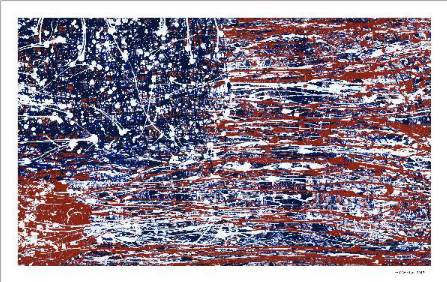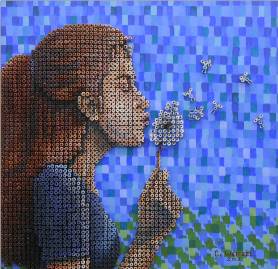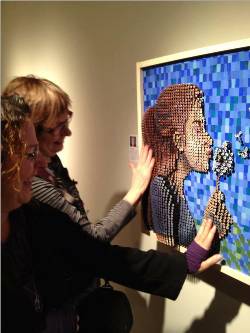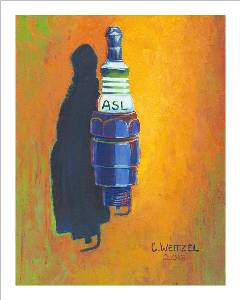Cynthia Weitzel
ART AS DEAF LIFE EXPERIENCE
As a Deaf artist, my point of view bears striking resemblance to those artists identifying themselves as belonging to an ethnic, minority or diasporan group whose culture has experienced a history of oppression in the most fundamental of ways. I see the language and process of art as my opportunity to document and reflect the history, life and perspective of our language and culture; also serving as a catalyst for thought and change towards greater understanding and acceptance.
Greatly touched and influenced by the genres of Expressionism, Abstract Expressionism, Social Realism, and De'VIA (Deaf View Image Art), my approach and style —both figurative and abstract —varies greatly pending on the subject of focus at the time. With my work, I am able to continue the development of my visual vocabulary through use of motifs and symbolism commonly recognized and understood by members of Deaf Culture but universal enough to make connections with viewers of any culture to which there are shared collective experiences.
Aspects of community oriented art and educational components are important elements of my projects. As well as experimenting with nontraditional materials and different techniques for making art more accessible and engaging.
A few examples of such work are narratives through high relief hand carved ceramic tiles or through screw art 3D painting that provides both a visual and tactile experience for the audience. Or ASL Action Painting where I borrow on the technique of the late abstract expressionist painter, Jackson Pollock - well known for his unique style of drip painting. While Pollock utilized sticks and brushes to create his drip marks, I instead dip my hands into the paint and allow the paint to fly off my fingers onto the canvas while signing American Sign Language (ASL). Each pattern is created using layers upon layers of ASL terms commonly associated with the subject of the piece. ASL Action Painting was born out of my experimenting with different techniques to both document and incorporate my native language into the process of art-making.
Since being invited to join the artist community of Anderson Center for Interdisciplinary Studies in Red Wing, Minnesota, as permanent year-round resident artist in 2011, I have had the benefit of being able to experiment and push boundaries without the pressures of succumbing to outside demands and expectations. The opportunities for support, learning and exchange within this community —and among the visiting artists-in-residence from all parts of the world —has been priceless.
Art itself is a universal language to which many of us relate to, or engage with, in one way or another. But art created through the lens of Deaf life experience is that much more meaningful to us "people of the eye."
ASL Action Paintings
Inspired by Jackson Pollock's process of spontaneous action painting (also known as drip paintings), I decided to experiment and see how well the process would work if I were to dip my hands into the paint then cast patterns from my fingers, instead of from sticks and brushes, while signing my native language —ASL (American Sign Language).
I wanted to see how effective this would be from the standpoint of working cultural footprints (or in this case, handprints) into my creative process. In a manner very abstract, I'm pleased with how the process seems to capture and preserve the energy and vibrancy of ASL. The reaction by viewers – Deaf and hearing alike—has been wonderfully positive.

American Deaf Culture
Acrylic medium on canvas
36" H x 60" W x 2" D
2013
When approaching this large-scale piece, I first decided on the traditional American colors of red, white and blue for my palette. I then created a list of at least ten ASL signs commonly associated with the topic of American Deaf Culture. From there, the work began; many layers of paint medium cast from my fingers onto the canvas while signing one word/color at a time.
The substrate—triple primed canvas—remains on the floor the entire time offering the greatest amount of resistance while receiving the paint medium from all directions. The paint medium consists of a recipe developed through much experimenting until the right mixture was developed. The recipe involves a mix of Golden acrylic paints, various mediums and varnish. The particular combination provides the right amount of raised texture while remaining somewhat flexible.
Each application is given at least 24 hours to dry in order to keep each layer crisp and distinct. In this piece, the beginning layers were created using the signs for: north, south, east, west, values, beliefs, traditions, culture, and America. Each pattern can be found and recognized if viewed long enough. For example; if you stand back from the piece and squint your eyes, you will notice the repeated circular pattern in blue made from signing the word America.
The final layer, which resembles an abstract likeness to the American flag, was created using the final three ASL signs: language (repeating left to right while alternating red and white to create the stripes); history (repeating in two directions creating the blue block area at upper left); and people (repeatedly in different directions atop the blue block area creating what look like shooting stars).
The likeness to the American flag was not planned; instead it was just one of those things that emerged during the process. In doing this, viewers from both Deaf and hearing audiences are drawn to the piece for both similar and different reasons. It is my hope that people will not only appreciate this piece for what it is, but also enjoy being able to figure out which signs were used to create each pattern – Enjoy!
SCREW ART
This line of work began as an experiment while attempting to create imagery and narrative that would read well both visually and by touch. The desire in wanting to produce more works involving tactile experience grew in response to Blind or DeafBlind fellow artists often asking me about my work. After much research and consultation with other artists having mastered various nontraditional techniques, the process of screw art became more and more intriguing. What I did not expect was how time consuming and labor intensive this work would be, but the outcome is worth it. Much to my surprise, the tactile experience seems to be craved and enjoyed by just about everyone. People love being able to physically interact with this work so it's become the perfect opportunity to show how accessibility benefits everyone, not just those of us who rely on it. This pleases me to no end.

Enculturation
Screws and acrylic on wood
26"H x 26"W x 6"D
2012
Enculturation is the second of three pieces within a triptych — Resilience, Enculturation, and Dandelion Fields Forever. The dandelion motif, commonly seen in works by minority or marginalized artists including Deaf artists like myself, is incredibly meaningful in the signing Deaf community.
The dandelion became a regular source of symbolism ever since made popular by the late ASL poet, Clayton Valli (1951-2003) in his poem simply titled Dandelion. In this poem, Valli used "simple nature imagery to convey the persistence of ASL despite oralists' best efforts to weed it out." (http://en.wikipedia.org/wiki/Clayton_Valli)
The choice of such substantive materials for this work offers an interesting juxtaposition to the seemingly fragile dandelion, while at the same time speaks to its incredible ability to adapt, thrive, and survive.
The choice of broad stroke pointillist method for the background was intentional so that viewers with low-vision could better experience the full range of vibrant hues so often unreadable or undetected within traditional fine art painting methods.

A couple months ago, my husband was working on his 1941 Chevy. He replaced the sparkplugs and brought one into the house at the same time I was writing the letter below to President Obama during the ASL for America campaign and petition to the White House. This old AC Delco spark plug became my inspiration for the analogy provided in this letter and later for creating this impasto oil painting.
12-10-2012
Dear Mr. President,
The legitimacy of American Sign Language has been widely studied, proven and accepted but has yet to be recognized
through executive order by the United States Government. This results in valuable and critical data being missed
through the U.S. Census; Deaf Education (primarily mainstream systems) policies regarding methods of instruction
that are inconsistent or ineffective; and continued marginalization of a large segment of U.S. born, tax paying
citizens.
The best analogy I can think of to explain what it is like as things currently stand is being like an engine
operating on bad spark plugs. It ends up being inconsistent, inefficient, unreliable and often misfires.
You can be the President to replace the spark plugs with new by "issuing the executive order directing federal
agencies such as the Department of Education, and other appropriate agencies to ensure that ASL is no longer
marginalized in any way, shape or form" [A. Clark via http://ASLfor.us/ 2012].
President Obama, I ask that you please respond to this grassroots effort by recognizing the legitimacy of American
Sign Language once and for all. This action would further more lead the way to validating American Deaf History and
Culture in the eyes of the public (local governments, school systems, health care systems, employers…).
Sincerely,
C. Weitzel

"ASL – Efficient, Effective & Economical"
Oil on clayboard
18" H x 14" W x 1" D
2011